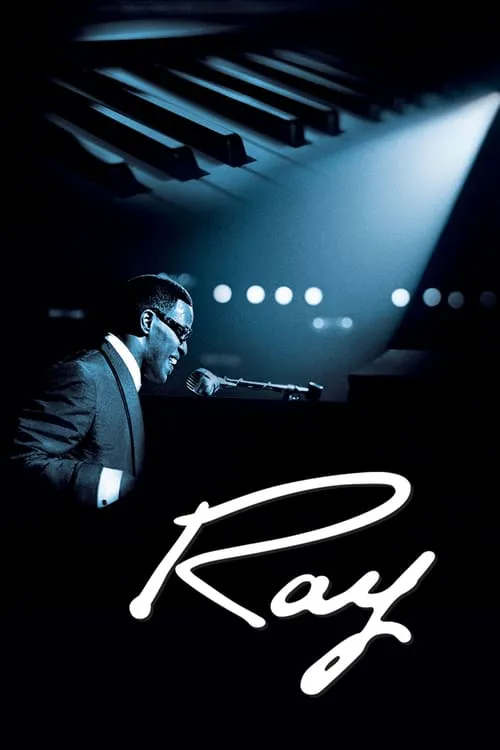Ray

Plot
In the early 1940s, Northern Florida was a hotbed of musical talent, with musicians pouring their hearts and souls into the blues, gospel, and country genres. It was against this backdrop that a young Ray Charles Robinson was born to Bailey and Aretha Charles on September 23, 1930. Ray's life would take a drastic turn when, at the tender age of seven, he contracted glaucoma, a painful eye condition that left him blind. The loss of his sight was a devastating blow to the young boy, and his devastated parents struggled to come to terms with his new reality. However, it was his fiercely independent mother, Aretha, who played a pivotal role in shaping his future. Despite the challenges ahead, she firmly believed in her son's potential and instilled in him a strong sense of self-reliance and determination. She sent Ray to the Florida School for the Deaf and the Blind, where he learned to adapt to his new circumstances and developed a passion for music. It was at the school that Ray discovered his gift behind the piano keyboard. His exceptional talent and dedication quickly caught the attention of the school's music instructor, Mrs. Matthews, who recognized his natural ability and encouraged him to hone his craft. Under her guidance, Ray's skills improved dramatically, and he began to develop his distinctive style, which blended the emotional intensity of gospel music with the soulful melodies of blues and country. As Ray's confidence grew, so did his ambition. He began performing on the school's radio station and soon gained the attention of local music promoters. In his late teens, Ray left the school and embarked on a tour of the Southern musical circuit, performing in various clubs, bars, and churches. His talent, charisma, and unrelenting energy quickly earned him a reputation as a rising star. During this period, Ray's music was deeply influenced by the African-American spirituals, which spoke to the struggles and triumphs of the African-American community. He was particularly drawn to the gospel singers, such as Mahalia Jackson and Sister Rosetta Tharpe, who infused their music with a sense of hope and redemption. Inspired by these artists, Ray began experimenting with gospel music, adding his own unique twist to the genre. One of the pivotal moments in Ray's career came when he met Daryl Hollis, a local musician who shared his passion for blues and gospel. The two collaborated on several songs, including the iconic "Baby, Let Me Hold Your Hand," which became a huge hit on the local radio stations. This collaboration not only helped launch Ray's career but also introduced him to the world of R&B, a genre that would eventually become synonymous with his name. As the 1940s came to a close, Ray's popularity was on the rise. He began touring the country, performing in prominent cities such as New York and Los Angeles. His music, with its unique blend of gospel, blues, and country, resonated with audiences from all walks of life. In 1949, he adopted the last name "Charles" and formed a band, which would eventually become one of the most influential musical ensembles of the time. Ray's breakthrough came in the early 1950s when he signed with Atlantic Records. Under the guidance of Jerry Wexler, Atlantic's president, Ray's career soared to new heights. His first album, "Ray Charles," released in 1956, was a critical and commercial success, featuring classics such as "Drown in My Own Tears" and "Lonely Avenue." This album not only solidified Ray's position as a major force in the music industry but also paved the way for his groundbreaking collaboration with gospel singer, Aretha Franklin. Ray's pioneering work in coupling gospel and country music not only redefined the boundaries of these genres but also created a new paradigm for R&B. His unique style, which blended the emotional intensity of gospel with the raw energy of blues and country, influenced a generation of musicians, including Aretha Franklin, Sam Cooke, and James Brown. Throughout his career, Ray continued to innovate and push the boundaries of music. He experimented with new styles, collaborated with other artists, and tackled socially relevant issues, all while remaining true to his musical vision. Despite the many challenges he faced, including racism, addiction, and personal struggles, Ray Charles remained an inspiration to millions of music fans around the world. Ray's legacy extends far beyond his musical achievements. He broke down barriers, paving the way for future generations of African-American musicians and challenging the status quo in the music industry. His courage, resilience, and determination in the face of adversity have made him an icon and a role model for artists and non-artists alike. In 1994, Ray Charles passed away, but his music and legacy continue to live on, inspiring new generations of musicians and music fans. His story, a testament to the power of passion, perseverance, and creativity, will be remembered for years to come as one of the greatest musical journeys of the 20th century.
Reviews
Recommendations




